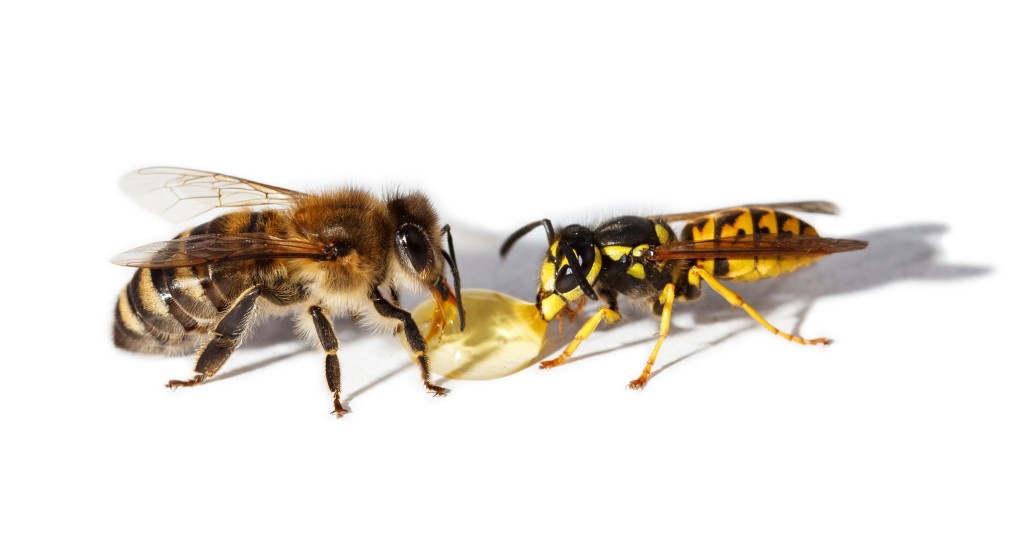Bees and Wasps – Different Pests with the Same Sting
Summer is time to think about bees and wasps. Now that we finally have warm weather and can enjoy outdoor activities, both can put a sting into your summer fun. Before you plan a backyard activity, put some thought into preventing bees and wasps from becoming a pest.
Identifying Bees Vs Wasps
Bees
These buzzing bees are related to many insects like the ant or wasp. They are known for pollinating flowers as well as creating beeswax and honey. Although bees may look scary — don’t worry, they’re not aggressive! Most bees don’t bother humans. In fact, most bees only sting out of self-defense.
- Living Quarters: A Geometric Waxy Hive
- Body Type: Long & Fat
- Body Characteristics: Hair on Body & Legs
- Abdomen: Round
- Legs: Flat & Wide
- Personality Type: Passive
Wasps
While they do look alike from a distance, wasps are actually quite different from bees. Rather than pollinating, wasps are considered predators. Some do eat nectar, fruit, etc. but others do prey on other insects; dead or alive. Wasps are an aggressive insect and can set their targets to sting multiple people.
- Living Quarters: A Papery Nest
- Body Type: Long & Thin
- Body Characteristics: Smooth Body & Legs
- Abdomen: Cylindrical
- Legs: Round & Waxy
- Personality Type: Agressive
Common Bee and Wasp Species in New York and Long Island
Of the 4000 species of bees and wasps in the United States, those common in New York include:
- Yellow Jackets: Measuring about a half inch in length, yellow jackets have a distinctive shiny yellow and black body and visible stinger. These aggressive pests pack a vicious punch and can sting repeatedly, so watch out. Because they are attracted to meat and sweet smells, they are a common unwelcome guest at picnics and cook outs.
- Hornets: These large stinging insects can reach an inch and a half in length and are known to attack perceived threats in swarms of hundreds of individuals, each capable of multiple stings. Varieties most common to Long Island, Westchester, Rockland County and New York City are deep yellow and black with thing long wings.
- Paper Wasps: They can be black, brown, even reddish—in fact there are 250 varieties in the United States. These wasps will aggressively protect their nesting site with extremely painful stings.
- Mud Daubers: These inch-long wasps have slender shiny black bodies with blue or yellow markings. They are generally not aggressive, but their nests can be an unsightly nuisance.
- Honey Bees: They’ve got a sweet name, but, get on the wrong side of them and you are in trouble. Honey bees are a little less than a half inch in length and have fuzzy dark yellow and black striped bodies.
- Bumble Bees: These large bees range from ¾ of an inch to an inch and a half in size and are covered by a fuzzy pale yellow and black pile.
- Carpenter Bees: They look like bumble bees, but a little less fuzzy. They can wreak havoc to any wood structure.
Bees, Wasps and Yellow Jackets: Each Cause Different Problems
While bees and wasps are often lumped together, they create different kinds of problems.
- Bumble bees become pests only when they perceive a threat. They won’t sting out of the blue.
- Honey bees and hornets are more aggressive and will swarm and sting if you disturb or threaten their hives. Nests can contain between 5,000 and 50,000 individuals, making swarms highly dangerous. Individuals will also sting if disturbed.
- Yellow jackets can nest under siding, in air conditioners, under roof soffits and trim and other places where they can cause structural or cosmetic damage. Large nests under roofs and within walls can cause leaks that lead to water damage and create opportunities for other pests to enter. They are also extremely aggressive
- Paper wasps and carpenter bees cause damage because they chew wood for their nests. Nectar stored in hives and nests can melt and rot, causing staining and a foul odor.
Stings are more than a nuisance. Nests near places where children play or where pets frequent can be a real danger. Large nests can break through into building interiors, creating a hazard to those inside. A number of wasp and bee species will swarm attack in masses of hundreds of individuals. Both bee and wasp venom can cause severe, even lethal allergic reactions.
How to Get Rid of Bees, Yellow Jackets and Wasps
You can find dozens of do-it-yourself ideas on the Internet, but you may want to think twice about removing a bee or wasp nest or trying to handle a yellow jacket infestation yourself. Besides the danger of getting stung, treating hives yourself can be a challenge. Treating an active nest during the day will kill just a fraction of the hive members. You need to know the species’ specific foraging and nesting habits to target the right treatment at the right time of day or year. Some species require multi-step treatments to ensure the infestation is truly gone. You don’t want the colony to merely relocate or return next season.
Knockout Pest Control Can Knock Out a Bee or Wasp Problem
Knockout Pest Control is your local expert at knocking out all kinds of bee and wasp problems–and we keep them down for the count. Every member of our team receives over 100 hours of classroom instruction and in-the-field training so you are guaranteed a knockout punch to your pest problem every time. We serve all of Long Island, New York City, and Westchester and Rockland Counties. Call 1-800-244-PEST or 1-800-244-7378 We respond like every pest problem is an emergency with fast, 24 hour service seven days a week. We don’t have the big red boxing glove in our logo for nothing!



